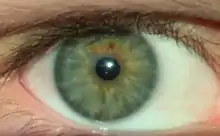Lipochrome
A lipochrome (from Greek λίπος ("fat") and χρῶμα ("color"))[1] is a naturally occurring, fat-soluble pigment.[2] Lipofuscin—a product of fat breakdown in lysosomes—is a type of lipochrome[2] that is associated with the decomposition of cell membranes. Beta carotene, a lipochrome, was found in the retina, pigment epithelium, and iris of cattle eyes.[3] Lipochromes can also be found constantly in the adrenals of adults. However, they are not present in these or other organs of infants; they are also present in the corpus luteum, liver, and fat, but were not found in recognizable / significant quantities in other organs apart the spleen. Golden to ruddy iris color has more correctly been identified as phoemelanin. However, yellowish carotenoid pigments do play some part in eye color, especially in birds and reptiles.
Lipochrome is a yellowish pigment and is responsible for the color seen in some eyes. Individuals with green eyes have slightly more lipochrome in their eyes as opposed to someone with darker brown, or even blue eyes, who may have more melanin as opposed to lipochrome. People with green eyes actually have no green pigment in their eyes. The increased amount of lipochrome, combined with the blue hue from the Rayleigh scattering in the iris, and the yellowish tint from the lipochrome pigment itself, produces a green colored iris. All eyes contain some amount of melanin in the back of the iris, but not all eyes contain lipochrome pigmentations.

References
- "Lipochrome word origin". Etymologeek. Retrieved 2021-02-18.
- "lipochrome", The Free Dictionary, retrieved 2021-02-18
- Bielig; Busch (1944). "Lipochromes in the retina, pigment epithelium and iris of cattle". Hoppe-Seyler's Zeitschrift für physiologische Chemie. 280: 56–63.